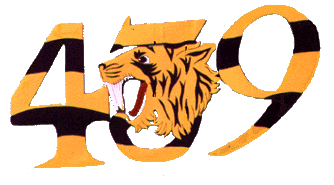|
History
of
 Squadron Squadron
  
Chapter
VI
Winter in the Netherlands
November 1944 January
1945
After four days of lamenting the met. reports "What a country for weather and fighting a war!" , and discussing the possibility of changing the squadron name to 439 Fleet, the pilots finally saw the sun break through the clouds on the 26th and they were soon in the air to prang three more of the Reich's
rail lines. On the first
outing, led by F/O Bob Laurence, a new trick was tried to throw off the enemy's flak predictors.
The pilots
climbed to 11,000 feet, considerably above their usual operational altitude, and then did a gentle descent towards the target near Bocholt, gaining speed all the time. The procedure seemed quite effective as no heavy flak was encountered. One direct hit was made on the rails, with several others very close.
Reconnoitering for ground targets, the pilots then found a locomotive which, they noted with great satisfaction, was pulling about ten other burned out engines.
|
Intentionally
left blank
|
Intentionally
left blank
|
F/O Laurence and P/O Angelini soon left the lead engine gushing clouds of steam and smoke. On the next trip John Carr's formation scored two cuts near
Gronau, and on the third mission Bing Crosby's group of eight made at least one and possibly a second hit on the tracks as well as damaging a small factory northwest of Wesel. Bing tried a new technique on this attack, bringing in his formation at right angles to the target with sections line abreast; all eight aircraft bombed in the time normally required for four.
Fighter escort accompanied two of the sorties and F/L Joe Cote had quite an unpleasant time warding off attacks by a persistent Allied Mustang. The other pilot fired a burst at the Typhoon, cutting the air line and hydraulics. On return to base Joe got his wheels down and landed safely without the flaps, but lacking brakes the aircraft ran off the end of the runway.
|
|
When heavy clouds grounded the aircraft on the 27th the squadron took the opportunity to drag its aircraft, pilots' tent and office tent out of the mire and move to a new site that was somewhat firmer under foot and not quite so noisy. The old dispersal had been rendered
"uninhabitable" by the presence of another squadron near by with some of its Tiffies parked in front of the two tents. Since the aircraft, standing out in the open, had to be warmed up every four hours, day and night, the noise at times was
"dammed
annoying".
  
Copyright
©1998-2016 Michael T. Melnick. All rights reserved
the
unofficial homepage of  Tiger
Squadron Tiger
Squadron
.
.
|
|